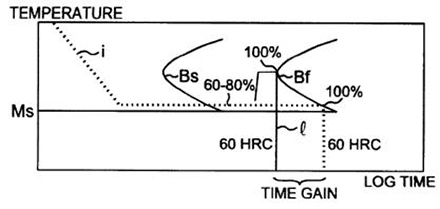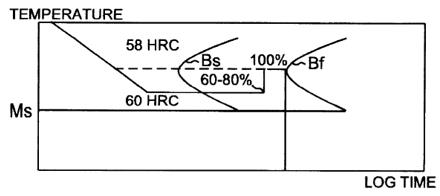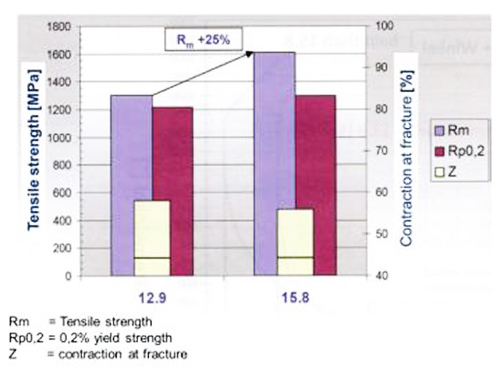Bainite Hardening of Steel: Part Two
Abstract
Bainite hardening or austempering has been a developing hardening technique over the past decades and is particularly well applied in the bearings industry.
Some key advantages of bainite hardening include a reduced size of the crystal lattice, which in turn leads to a reduced distortion of the part. Furthermore, in most applications a bainitic material shows desirable compressive stresses at the surface.
In the last years an increased interest in bainite hardening processes for different applications can be found. Besides the applications in the bearing industry, where salt bath quenching is state of the art, more and more applications can be found, where bainite hardening generates advantages in comparison with martensitic hardening and tempering. Bainite hardening allows higher yield strength with same hardness as tempered steel, higher tensile stresses and leads to desirable compressive stresses at the surface. However, it is necessary to carefully select the material grade according with the wall thickness or weight of the parts and the desired yield strength. Furthermore, the cooling strategies have to be optimized to minimize the dwell time in the salt bath.
As an illustration, it is showed a method of complete bainite hardening of steel for use in bearings and other load carrying components, wherein bainite transformation is performed at a temperature just above the martensite formation temperature, transforming 25%—99% of the austenite into bainite at said temperature, and then increasing the temperature to speed up the transformation of the remaining austenite into bainite.
Bainite hardening is sometimes preferred in steels instead of martensite hardening. This is because a bainitic structure in general has better mechanical properties, e.g., higher toughness, higher crack propagation resistance, etc. Therefore, for critical components such as bearings or other load carrying components especially subjected to fatigue, a bainitic structure could be most suitable. Bainite hardening is widely used to produce components with high strength and hardness. For a given steel, the bainite structure often exhibits superior mechanical proper ties and structural stability compared to a martensite structure. The disadvantage with bainite hardening, however, is the long process time. To reduce the processing time for isothermal bainite transformation, it is necessary to increase the bainite transformation temperature. However, this will reduce the hardness which could affect the properties of the component.
Figure 1 is a schematic drawing of two heat-treating cycles which give approximately the same hardness but with one having a significantly shorter transformation time, and Figure 2 is a schematic drawing of two heat-treating cycles with the same transformation time but with one having significantly higher hardness.

Figure 1: % transformation of austenite into bainite

Figure 2: % transformation of austenite into bainite
In Figure 1, the temperature versus log time is plotted for two cycles giving approximately the same hardness, i.e., 60 HRC. Ms denotes the martensite start point, which normally varies between about 180°C and 280°C, depending on the composition of the steel alloy. Bs denotes the start of bainite transformation and Bf denotes the finish of bainite transformation. In order to obtain maximum hardness, the temperature should be close to the martensite start point. This, however, results in a very long transformation time Which is not economical, which is illustrated with the dotted line i in Figure 1.
According to the presently claimed invention, illustrated with the solid line 1 in Figure 1, the bainite transformation is performed slightly above the Ms point until more than 25% up to 99%, preferably 50%—90%, most preferably 60%—80%, transformation has occurred, and the remaining hardening is performed at an increased temperature at which the transformation proceeds with increased velocity to 100%. The temperature can be increased any amount so as to result in a complete bainite transformation. The amount of temperature increase and time to complete transformation can be determined by one of ordinary skill using known techniques. The fraction of bainite formed at the higher temperature has not shown any noticeable effects on the hardness.
Another Way to use the process according to the presently claimed invention, is to increase the hardness for a given transformation time, which is illustrated in Figure 2. In the process illustrated with a dashed line, the transformation takes place at the optimum temperature in view of the velocity of transformation, versus time consumption for 100% transformation to bainite. This optimum temperature can be determined by the skilled artisan using conventional techniques. The resulting material has a hardness of 58 HRC. According to the presently claimed invention, the bainite hardening is performed along the solid line at a lower temperature to more than 50%, preferably 60%—80%, bainite transformation, and then the temperature is increased to the optimum temperature. This results in a steel alloy with a hardness of 60 HRC, using the same transformation time. In practice, both features could be achieved compared to traditional bainite hardening, i.e., shorter transformation time and higher hardness. The results also show increased structural stability Which is very important in many applications.
Advantages and disadvantages of bainite hardening
The advantages or disadvantages of the process might vary in dependence with a special application, however, some general rules can be listed: As mentioned before, bainite consist of ferrite with fine carbide precipitations. Therefore, the changes in volume are reduced, followed by a reduced size of the crystal lattice, which leads to a reduced distortion of the parts. Furthermore, in most applications the tempering process can be saved. The bainitic material shows desirable compressive stresses at the surface, which are significantly higher than with martensitic hardening. Further advantages are higher yield strength with same hardness as tempered steel, higher tensile stress and improved notch impact strength. Finally, the residual austenite is lower than with martensitic hardening. As a disadvantage it has to be mentioned, that the dwell time might be very long and therefore the process might get uneconomical. Furthermore, the process parameters have to be carefully adjusted to the parts geometry and the material. Finally, the austempered material usually does not achieve the same maximum hardness as martensitic hardened material.

Figure 3: Advantage of bainite hardening over martensitic hardening
Read more
Find Instantly Thousands of Heat Treatment Diagrams!
Total Materia Horizon contains heat treatment details for hundreds of thousands of materials, hardenability diagrams, hardness tempering, TTT and CCT diagrams, and much more.

Get a FREE test account at Total Materia Horizon and join a community of over 500,000 users from more than 120 countries.